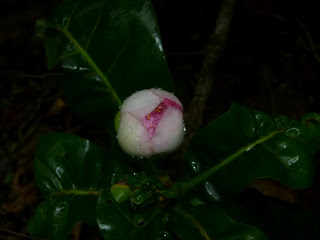As usual, we never once touched the beach. Hualien to Fangliao to Kenting to my scooter hook-up and then to the forest. Only stopping for bananas and coffee along the way.
Three things were notable on this journey, aside from the fortnightly scientific work that needs to be done.
First, we got to explore Sheding, a new section of the park to us (we had actually been there before, three years ago approximately, but never covered as much ground as we did this trip nor did we get to witness the extent of the park. This little adventure remedied that, and also provided me with ample figs to extract seeds from!). Second, we got to witness a cool, albeit not-so-amazing-if-you-grew-up-in-the-tropics, plant cycle. Lastly, we got to see, once again, the gem faced civet. Lurking around the palms and the larger species in the garden, as they seem to like to do, we caught a prolonged glimpse of one little critter. Here are the stories:
Prologue: We hiked through Sheding Park in search of more figs from my little favourite Moraceae, Ficus benjamina. Along the way we ended up hiking through a cave full of (potentially) macaque feces, watch macaques feed (they were largely undeterred by our presence, quite unlike the troop(s) that occupies the forest plot itself - habituation in progress, perhaps) and finally get a nice view from atop a platform. However, if you an spot it, the macaques also played a role in this part of our day too as they have decided to take advantage of the covered platform and gather here....and poo. It was everywhere. Everywhere.
The plant:
Barringtonia asiatica. To make a wonderfully amazing biological story short, this is a plant that occupies a pollination niche separate from much of the angiosperm world. B. asiatica (hereafter BA) has evolved alongside moths and bats to complete its sexual cycle, and in doing so has turned its proverbial face on the daytime and its cohort of species and has become a plant of the night. The cycle goes something like this:
Late afternoon preparation....
Darkness display....
And a few weeks later this seed develops...
Having evolved a partnership with the night, this species will only be seen to bloom after it is dark. A chemical reaction to the onset of darkness promotes the waiting flower to bloom and entice pollinators with a bouquet of fragrances and the promise of nectar. They come, they pollinate, and the plant drops the male parts (stamen) and the petals and sepals (corolla and calyx) to the ground and gets to work putting energy towards growing a seed. This leads to a "morning after" crime scene of sorts, as seen below. Make it bigger if you want to catch all the beautiful aborted parts strewn across the ground.
An interesting sidebar here is the timing of all the flowers on a single tree. There is a distinct asynchronous pattern within each tree, so no single tree will every produce all its flowers in one night. There is a distinct flowering season, but no distinct flowering night. So, you can come back and see the same sex show the night after the first, and then again and again until the tree is done. As a result, the pollinators are kept at bay (and kept in the area) in a process called trap-lining, whereby the, say moth, can visit tree A - B - C - D on monday, and then return to the same trees the next night, and then the next, continuously until the season is over. The term is taken directly from the same hunting technique where one checks the same "lines" of traps each day/week. Trap-lining is a trait that is often cited as something the pollinators do, but I like to think of it as a result of the circumstances that the trees establish. I like to think the trees are in charge. Semantics, I know.
Night time show on the branches of BA.
Moi, while I am kanning a piao liang specimen.
And, lastly - our friends of the trees (the ones that dont try to intimidate me.....*old man fist shake to the macaques*). Civets!
While we were unilaterally consumed by the night flowers, Crystal spotted upon a branch above two eyes peering back at us. It lingered, we watched...it lingered, we watched...it left. Civets are not of concern ecologically, but their role in forest ecosystems is definitely important, especially for Ficus species, so it is always nice to see them around. And they are damn cute.
And that does it. That was the weekend - we plodded through the forest for a day collecting data and figs, I sat in a lab and toyed with experimental design queries in trying to get the seeds to tell me their secrets and counted sesame sized seeds, Crystal hiked the trails and pondered life (whatever for, I am not sure..we know the answer is 42), and we eventually made it back to Hualien to be witness to a violent CRACK of an earthquake. Not a rumble, tremor, shift, shake....but a crack. Like somebody split a bowling ball in half, only the bowling ball was our planet, and the crack was under our feet. F you see kay - ing most scary moment of Taiwan yet.









